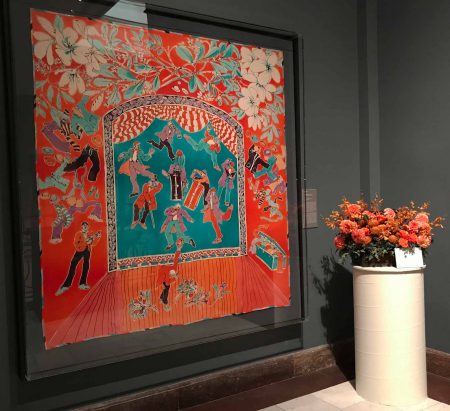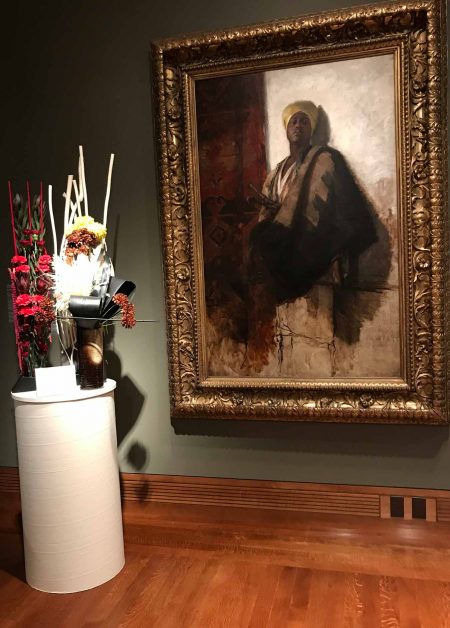
The Cincinnati Art Museum offered Art in Bloom October 26 – 29. Over 5,000 visitors made the trip to see the pairing of artwork with floral arrangements.
The celebration is in its ninth year and offered biennially. For four days, visitors could see significant works of art chosen by the curators from the museum’s permanent collection, including paintings, ceramics and sculpture, and matched them to floral interpretations. In addition, they could take advantage of morning and afternoon teas, a floral presentation, family activities such as a scavenger hunt, docent tours and jazz.
Over 80 floral arrangers interpreted various pieces, such as the show’s signature work Vaudeville (c. 1982) by Lenore Davis, (American, 1936–1995) a fabric artist who worked in the latter half of the twentieth-century, living and working in Newport, Kentucky. According to Jill Dunne, CAM director of marketing and communication, “Much of Davis’ work centers on the idea of the body in motion and intermingled human forms.” Eden Floral Boutique interpreted the art with bright orange and pink flowers. (See image.)

Regional artist Frank Duveneck, (American, 1848-1919) is well known in the Greater Cincinnati area. For this show, curators chose Guard of the Harem (c. 1880). Brenda Baird represented Moto Ikebana, a garden club with emphasis on the Japanese art form of using fresh flowers with rules and principles revealed in nature. She picked flowers including carnations and chrysanthemums. (See image.)
Visitors saw Romanian Blouse by Henri Matisse (French, 1869 – 1954) interpreted by Priscilla Dunn and Nan Witten, members of the Christ Church Cathedral Flower Guild. Matisse’s fascination with folk culture inspired their creation. (See image.)
Artist Becky Linhardt interpreted an African doll. (TBA) She said, “It was intended to honor the imaginations of children all over the world who can take bits of string, scraps of wood or even flowers and imagine them to be something more.”

An unusual combination was a bedstead (c. 1882-1883) designed by Benn Pitman (1822–1910) and carved by Adelaide Nourse Pitman (1859–1893). Beverly Mussari of the Herb Society of Greater Cincinnati used a black container with Asiatic copper orange lilies and eucalyptus to match the furnitu
Floral arrangers, who came from across the TriState as well as Baltimore and California, built upon elements and concepts within a selected work of art, creating a dialogue between the two pieces. Some designers were from professional florist shops, a church’s flower guild, local garden clubs as well as individuals.
Entrants needed to meet certain material requirements. Serena Urry, chief conservator, personally inspected the arrangements before they were placed throughout two floors of the museum.
–Laura Hobson